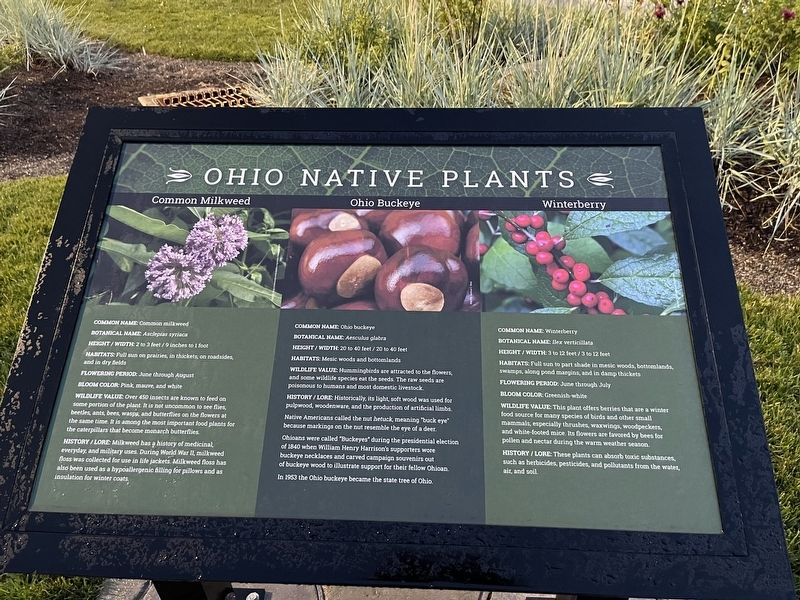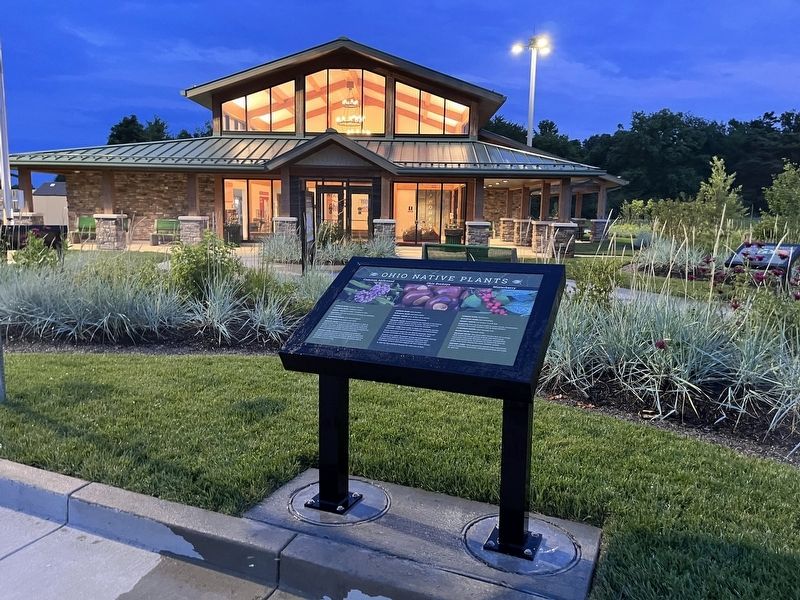Turtlecreek Township near Lebanon in Warren County, Ohio — The American Midwest (Great Lakes)
Ohio Native Plants
Botanical Name: Asclepias syriaca
Height / Width: 2 to 3 feet / 9 inches to 1 foot
Flowering Period: June through August
Bloom Color: Pink, mauve, and white
Wildlife Value: Over 450 insects are known to feed on some portion of the plant. It is not uncommon to see flies, beetles, ants, bees, wasps, and butterflies on the flowers at the same time. It is among the most important food plants for the caterpillars that become monarch butterflies.
History / Lore: Milkweed has a history of medicinal, everyday, and military uses. During World War II, milkweed floss was collected for use in life jackets. Milkweed floss has also been used as a hypoallergenic filling for pillows and as insulation for winter coats.
Botanical Name: Aesculus glabra
Height / Width: 20 to 40 feet / 20 to 40 feet
Habitats: Mesic woods and bottomlands
Wildlife Value: Hummingbirds are attracted to the flowers, and some wildlife species eat the seeds. The raw seeds are poisonous to humans and most domestic livestock
History / Lore: Historically, its light, soft wood was used for pulpwood, woodenware, and the production of artificial limbs.
Native Americans called the nut hetuck, meaning "buck eye" because markings on the nut resemble the eye of a deer.
Ohioans were called "Buckeyes" during the presidential election of 1840 when William Henry Harrison's supporters wore buckeye necklaces and carved campaign souvenirs out of buckeye wood to illustrate support for their fellow Ohioan.
In 1953 the Ohio buckeye became the state tree of Ohio.
Botanical Name: Ilex verticillata
Height / Width: 3 to 12 feet / 3 to 12 feet
Habitats: Full sun to part shade in mesic woods, bottomlands, swamps, along pond margins, and in damp thickets.
Flowering Period: June through July
Bloom Color: Greenish-white
Wildlife Value: This plant offers berries that are a winter food source for many species of birds and other small mammals, especially thrushes, waxwings, woodpeckers, and white-footed mice. Its flowers are favored by bees for pollen and nectar during the warm weather season.
History / Lore: These plants can absorb toxic substances, such as herbicides, pesticides, and pollutants from the water, air, and soil.
Topics and series.
Location. 39° 24.936′ N, 84° 7.378′ W. Marker is near Lebanon, Ohio, in Warren County. It is in Turtlecreek Township. Marker is on Interstate 71, 2.1 miles east of Ohio Route 123, on the right when traveling south. Touch for map. Marker is in this post office area: Oregonia OH 45054, United States of America. Touch for directions.
Other nearby markers. At least 8 other markers are within walking distance of this marker. A different marker also named Ohio Native Plants (a few steps from this marker); a different marker also named Ohio Native Plants (a few steps from this marker); a different marker also named Ohio Native Plants (within shouting distance of this marker); Ohio Buckeye Tree (within shouting distance of this marker); a different marker also named Ohio Native Plants (within shouting distance of this marker); a different marker also named Ohio Native Plants (about 500 feet away, measured in a direct line); a different marker also named Ohio Native Plants (about 600 feet away); a different marker also named Ohio Buckeye Tree (about 600 feet away). Touch for a list and map of all markers in Lebanon.
Credits. This page was last revised on February 6, 2023. It was originally submitted on June 30, 2022, by Devry Becker Jones of Washington, District of Columbia. This page has been viewed 73 times since then and 7 times this year. Photos: 1, 2. submitted on June 30, 2022, by Devry Becker Jones of Washington, District of Columbia.
Editor’s want-list for this marker. Clear, daylight photos of the marker and its context • Can you help?

